Excerpts from Jim Conrad's
Naturalist Newsletter
entry dated September 8, 2022, issued from near Tequisquiapan, elevation about 1,900m (6200 ft), N20.565°, W99.890°, Querétaro state, MÉXICO
PINCUSHION CACTUS
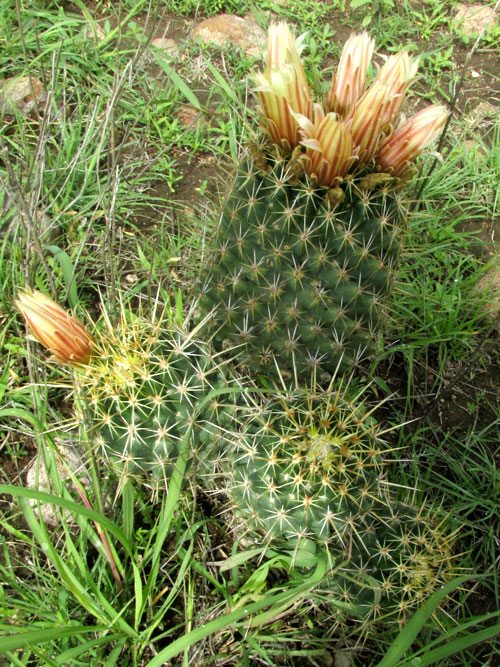
On a grossly overgrazed, rocky, eroded, thin-soiled slope, the above cactus was almost in bloom and I figured I'd best take the picture right then. Earlier in the same area I'd visited another of this species for several days anticipating the flowering, but right before it did, someone robbed it. Cactus thievery is big business here and the more interesting species are disappearing before my eyes.
The columnar body is "tuberculate," meaning that the spine clusters in their areoles are atop little mounds, the tubercles, arranged in a spiraling manner around the body. In certain genera areoles with their spines develop atop slender ridges running from top to bottom.
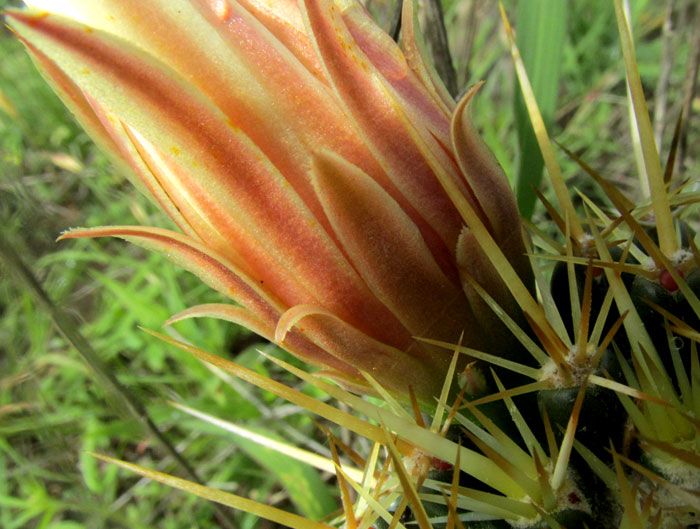
The unopened flowers' slender tepals are pinkish in the middle with yellowish margins. At the tubercles' tops the areoles surround the spines' bases with white, woolly hairs.
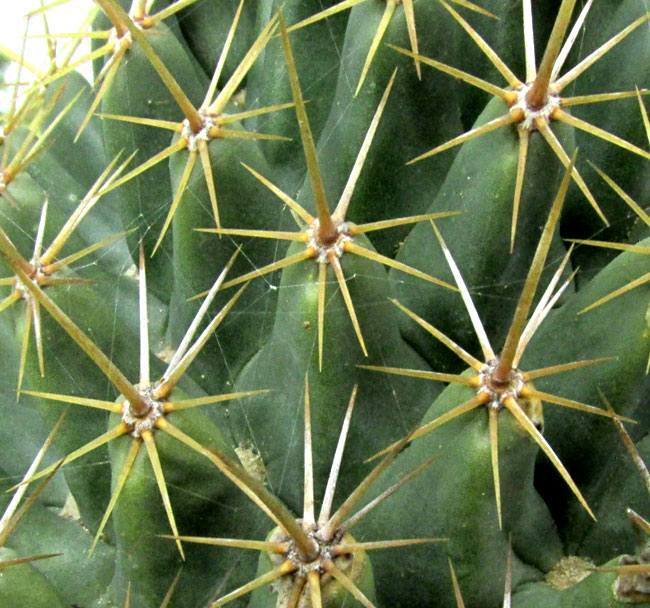
The tubercles are narrow at their tops but swell at their bases. In each spine cluster there's a longer, thicker spine in the center, surrounded by ten or so radial spines, all spines round in cross section.
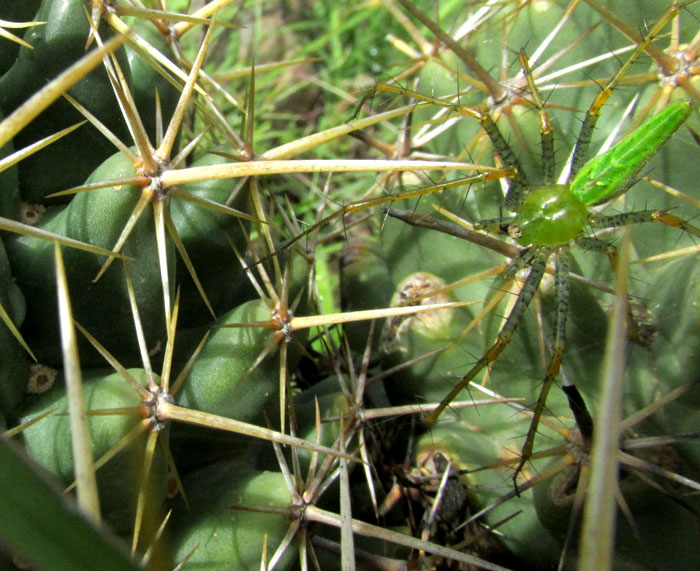
The spines can order themselves a little differently. The Green Lynx spider shows the relative size.
This is CORYPANTHA ERECTA, endemic just to the semiarid uplands of central Mexico, in the states of San Luis Potosí, Guanajuato, Hidalgo and here in Querétaro. The species is a favorite for collectors and gardeners. It's clear that the people who rob cacti here know what they're doing, because they focus on the rare species that produce the most money. It's also clear that they care nothing about conservation, for often dug-up cacti that prove less than perfect, or are shoots too small to sell quickly, are found thrown beside their hole, their roots in the air.
from the February 23, 2007 Newsletter issued from Sierra Gorda Biosphere Reserve, QUERÉTARO, MÉXICO
A CACTUS FROM BELOW CAMARGO, QUERÉTARO
Look here:
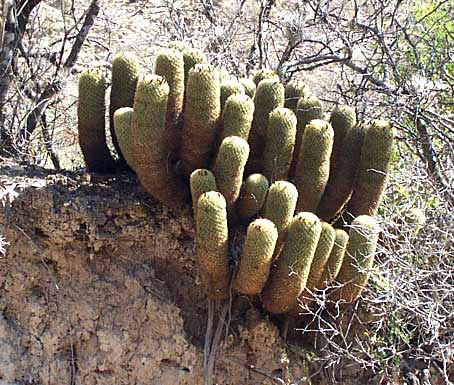
Have you ever met such a congenial-looking cactus family? These, about 1.5 feet tall, grew at the rim of an arroyo's vertical bank. I think they're CORYPHANTHA ERECTA, endemic to three states here in north-central Mexico, but grown widely elsewhere because they are so handsome. I couldn't get to the plants to snatch a flower for certain identification, but they match pictures on the Internet.
entry from field notes dated January 20, 2023, taken in scrub along ridgetop ~1.5km south of Camargo, elevation ±1,700m (7280 ft); bedrock of fine-grained, calcareous mudrock; Querétaro state, MÉXICO, (N21.09°, W99.73°)
YOUNG PINCUSHIONS ON A DRY RIDGE

The above cacti sheltered beneath a dry-season-leafless, scrubby, spiny tree on a dry ridge below Camargo. At first it seemed impossible to identify them because the spines were so completely mantling the bodies that I couldn't answer the fundamental questions of whether the bodies were composed of separate tubercles, were deeply divided into ridges, or smooth. Would the bodies remain spherical or eventually grow taller? The one good field mark for identification purposes was that the bodies clustered freely. Finally I noticed another mark: In the above picture, at the lower, right corner, certain bodies are beginning to grow upward, to elongate, as better shown below.

Also on this elongating individual the spines are so dense that the body's surface can't be seen. However, note that many overlapping, paler spines remain close to the body's surface, but fewer longer, darker spines rise vertically from cluster center, to well above the level of overlapping pale spines,and that's a good field mark.

On one body, a single spine cluster, shown above, was positioned so that it revealed more important details. In the above picture, the center of the spine cluster occupies the center of the picture surrounded by a dark zone, the body's green surface. Here it's seen that maybe 18-20 spines radiate outward from a center point, as one spine, turning a little darker especially toward its tip, emerges from the radiating cluster's center.
Of the 670 or so cactus species occurring naturally in Mexico, the few details registered here eventually pointed to only one species. Moreover, we've seen it before, as is documented in above 2007 entry also from here near Camargo. It's the Pincushion Cactus, Coryphantha erecta.
The ones seen last year, pictured at the top of this page, were more mature, taller individuals photographed during the rainy season. That may explain why the tuberculate, green body surfaces are so easy to see; rains have swollen the tubercles. Those cactus's radial spines were much fewer, but the Flora del Bajío describes this species' areoles as producing 11-18 radial spines. Our plants being so young and in such an exposed, ridge-top location may account for the denser spine cover, the denser cover providing more protection.
Supporting the identification is that pictures on the Internet show individuals very similar to ours identified as Coryphantha erecta. The bodies' faint honey color, the mixture of many pale spines close to the body along with fewer longer, darker spines extending above them, and the manner and number in which the bodies cluster, all is distinctive.
Earlier it was mentioned that this species, despite being such a commercial success worldwide, in the wild is endemic only to the semiarid uplands of central Mexico, in the states of San Luis Potosí, Guanajuato, Hidalgo and here in Querétaro. It's impressive to see how limited that area really is on the newly available GBIF distribution map.